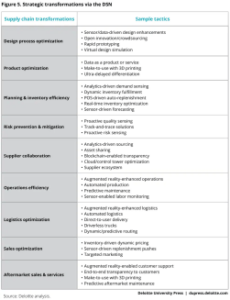Supply chains are typically linear, with a straight progression of:
1. Plan
2. Design
3. Source
4. Deliver
In traditional supply chains, each step depends on the one preceding it, and inefficiencies in one phase can cause a domino effect of similar inefficiencies in the next stages.
Stakeholders also have zero visibility of other processes, which restricts their capacity to react or manipulate their activities.
But today that’s changing. As supply chains are transitioning from a straight sequence into interconnected, dynamic systems capable of evolving into an optimal state with time and can easily incorporate ecosystem partners.
This transition from sequential, linear supply chain operations to a dynamic, interconnected open system will lay the foundation for how businesses will compete in the future.
We term this open interconnected system, a digital supply network (DNS). And brands who cannot optimize their supply chain for the transition to a DNS may lose out in efficiency to those that do.
How does a Digital Supply Network (DNS) Function?
DSNs integrate data from various locations and sources to push the physical task of production and distribution.
Many companies already on the way to creating DSNs are changing their focus from optimizing and managing discrete functions, like manufacturing and procurement.
Rather, they often use digital supply networks to focus more on how the entire supply chain can easily achieve brand objectives while informing portfolio strategies, corporate and business units.
So DSNs allow supply chains to steadily become an integral part of decision making and strategic planning.
Organizations can now create and leverage many DSNs to complement various aspects of their strategy and efficiently target particular needs.
Transitioning from a Traditional Supply Chain to DSN – the Impacts
The purpose of any successful supply chain majors in the movement of finished goods, capitals, materials, and other assets from location to location.
At its core, though, a supply chain comprises numerous transactions: the exchange of money, time, information, or physical goods for any other unit of value.
However, dramatic digital and technological developments such as enhanced computing power and decreased overall costs have affected the traditional supply chain in various ways, such as an increase in production innovation and a decrease in transaction costs.
Reduction in Transaction Costs
The boost in power and technology efficiency has revealed itself in the drastic reduction of transaction costs for company operations both externally and internally.
It doesn’t have to be prohibitively time-intensive or expensive to acquire insight into each segment of operations anymore, or to understand supplier or customer demand patterns in-depth.
Whilst the linear flow of design, creation, and movement of physical goods stays unchanged, all underlying data now moves around and through supply chain nodes, dynamically and in real-time.
These new interconnections between processes and subprocesses transform supply chains into predictive and efficient networks.
When transaction costs fall, the capacity to transact with other partners rises. This allows transitioning to networked supply chains as businesses can connect with different partners when necessary to deliver increased value.
Production Innovation
Production in the physical world is changing because of dramatic improvements in the way matter is manipulated and the computing power that facilitates such processes with the goal of production.
Enhanced capital equipment will lead to less of it being needed to begin production. And with less capital, the minimum efficient scale drops, and production is allowed to locate nearer to demand.
How to Shift from a Traditional Supply Chain to a Digital Supply Chain
Once you’ve decided to transition your supply chain from linear to DSN, you must consider how to configure your supply networks to execute your plan.
To configure and achieve a DSN driven approach you can execute many supply chain transformations.
Here’s a pictorial explanation of 9 strategic transformations brands can make via leveraging DSN and a list of tactics to achieve each transformation.

Take EasyJet, for example, that offers virtual walkthroughs via smart glasses to enable two-way communication between its central engineering team and remote technicians.
With this, technicians can perform complex maintenance jobs and eliminate downtimes. The real-time walk-throughs enable the supply networks to move without hindrance and ensures a smooth transition from linear to digital networks.
Implementing a DSN – the Optimization
For business executives accustomed to traditional linear communications and data, the transition to real-time access to intelligence and data changes the way they do business.
Once your organization chooses to adopt a DSN, consider how to create, connect, and utilize the various industry-driven innovations that power it.
Before you create a DSN, it’ll be helpful to take the pathway of information creation, analysis, and implementation as a loop.
Integrating digital information from various sources and locations drives the physical actions of manufacturing and distribution in a continuous cycle.
Real-time access to intelligence and data is largely driven by the cyclical and continuous flow of data and actions between the real and digital world.
The flow happens via 3 iterative steps called the physical-to-digital-to-physical loop:
Physical-to-digital: This step involves capturing information from the physical world to develop a digital record from the data.
Digital-to-digital: The digital to digital phase involves sharing information to uncover meaningful insights via advanced analytics, artificial intelligence, and scenario analysis.
Digital-to-Physical: This deals with the application of algorithms to translate digital-world strategies to valuable data able to initiate action and change physically.
Conclusion
Traditional supply networks are phasing out due to their limitations and the hitches they cause in the supply chain.
And because of this, many businesses are opting for a new supply chain optimization by transitioning to digital supply networks.
However, the transition is tough and may ruin a supply chain if not done properly.
But by following the tips and ideas in this piece, transitioning and optimizing these new supply networks should be a lot easier.
Will Schneider is the founder of InsightQuote, a match-making service for B2B services, and writes informative posts about fulfillment services at Warehousing And Fulfillment.
To read the original post, click here
